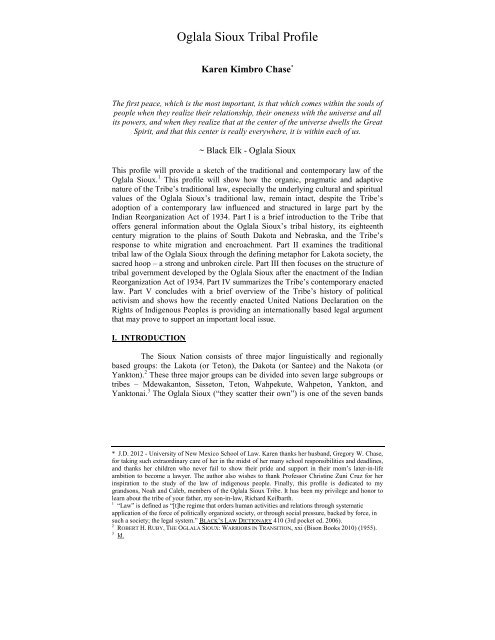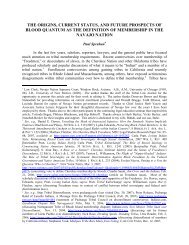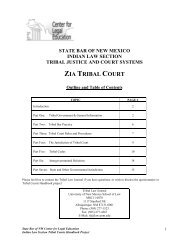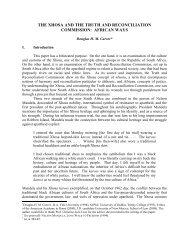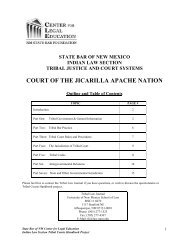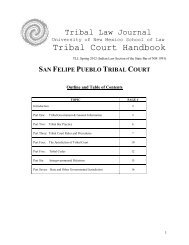Oglala Sioux Tribal Profile - Tribal Law Journal - University of New ...
Oglala Sioux Tribal Profile - Tribal Law Journal - University of New ...
Oglala Sioux Tribal Profile - Tribal Law Journal - University of New ...
Create successful ePaper yourself
Turn your PDF publications into a flip-book with our unique Google optimized e-Paper software.
6 TRIBAL LAW JOURNAL Vol. 12all the supernatural and was the source <strong>of</strong> all power. Men, bothas individuals and as a group, were believed to be dependent onthis power reservoir. They must humble themselves andsupplicate it for a successful living. . . . Leadership wasconnected in the minds <strong>of</strong> the traditional <strong>Sioux</strong> with theacquisition <strong>of</strong> supernatural power rather than with any power ortalents or skills inherent in the individual himself. People shouldlive a normal life, be brave, strong, generous, and loyal, andperform their proper functions and ceremonies as men, women,and children. Otherwise, they would suffer sickness andmisfortune. 50The Sacred HoopThe sacred hoop (cangleska wakan) defines Lakota society as a strong andunbroken circle. 51 “If danger lurked outside the circle, the people sought peace,prosperity, and cooperation within.” 52 The <strong>Oglala</strong>s‟ daily life revolved around thetiyospaye (band), which were <strong>of</strong>ten ten or more bilaterally extended families. 53 Thetiyospaye was the basic governmental unit where tribal traditions and laws weretaught and enforced within the family. 54 Larger bands were divided into severalcamps (wicoti). 55 Central to the tiyospaye was forming camps into circles, in closeproximity to one another. 56 The most revered families had a reserved place <strong>of</strong>honor opposite the camp entrance. 57 The holy men (wicasa wakan), “whose dreamsand visions marked them as the Great Mystery‟s intermediaries, understood thesacred symbolism <strong>of</strong> the circle.” 58 The holy men observed that everything in naturewas round – humans, animals, the sun, moon, stars, rocks, and “Yum theWhirlwind,” the younger brother <strong>of</strong> the South Wind. 59 By organizing lodges andcamps into circles was to dwell in the circle and live in the cosmic center. 60 It wasan opportunity to commune with divine forces. 61 “Ostracized families were forcedto move their tipis outside the circle, a punishment most Lakotas could scarcelybear.” 62 The significance <strong>of</strong> the circle was reflected in the holy man Black Elk‟sexplanation <strong>of</strong> his ability to interact with small children, “I who am an old man amabout to return to the Great Mysterious and a young child is a being who has justcome from the Great Mysterious; so it is that we are very close together on thecircle <strong>of</strong> life.” 63Kinship Relationships50 GRINNELL, supra note 5, at 18.51 PRICE, supra note 7, at 1-2.52 Id. at 2.53 Id.54 Danielle Her Many Horses, <strong>Oglala</strong> Lakota Nation <strong>Pr<strong>of</strong>ile</strong>, 2 TRIBAL L. J. (2002).55 PRICE, supra note 7, at 2.56 Id.57 Id.58 Id.59 Id.60 PRICE, supra note 7, at 1-2.61 Id.62 Id.63 Id.
2012 OGLALA SIOUX TRIBAL PROFILE 7Kinship relationships ordered <strong>Oglala</strong> <strong>Sioux</strong> society and shaped theattitudes and behavior <strong>of</strong> the <strong>Oglala</strong> <strong>Sioux</strong>. 64 Kinship responsibilities and politicalcustoms were believed to protect the sacred hoop and keep it alive in the people‟shearts by minimizing conflict. 65 Children were instructed from early childhood thatit was their duty throughout their lives to be a “good relative.” 66 This aspirationincluded sharing wealth with those who were less fortunate. 67 It was through anattitude <strong>of</strong> communalism that comfort and security were fostered and supported. 68“Acts <strong>of</strong> generosity reinforced the lesson that kinship ties were more precious thantangible goods.” 69Each member <strong>of</strong> the tiyospaye, male or female, old or young, bloodrelated to not, learned from earliest childhood how to conduct himself or herselfwithin the group. 70 The accepted use <strong>of</strong> Lakota kinship terminology reflectedgender, generation, and birth order, and established behavioral rules and moralobligations. 71 A younger brother addressed his older brother as ciye; an olderbrother called a younger sibling misunkala. 72 A woman referred to her olderbrother as tiblo and her older sister as cunwe. 73 Grandchildren called their maternalgrandmother onci, or oncisi, and their paternal grandmother kunsi. 74 A maternalgrandfather was called tunkansi, and a paternal grandfather was called tunkasila. 75A woman called her husband mihingna and a husband called his wife mitawicu. 76This system promoted peace and harmony within the tiyospaye, and was a culturalcode <strong>of</strong> conduct reflecting the rules and customs <strong>of</strong> the band. 77Leadership<strong>Oglala</strong> leadership concepts, like itancan (symbolic fathers <strong>of</strong> bands ortiyospaye), headmen, and warriors, reflect the ongoing traditional attitudes <strong>of</strong> the<strong>Oglala</strong> toward political institutions, social norms, religious practices and the law. 78The tiyospaye was the source <strong>of</strong> group consensus and legislative duties, althoughthere was no recognized centralized political body. 79 Councils were formed basedon the population <strong>of</strong> the member camp or camps. 80 Leaders that emerged wereexpected to be “kind, generous, patient, wise, diplomatic, and brave.” 81 Leaderswere also chosen based on their spiritual powers or by reaching a certain age. 82 It64 PRICE, supra note 7, at 2-3.65 Id. at 5, 24.66 Id.67 Id. at 3.68 Id.69 Id.70 PRICE, supra note 7, at 3.71 Id.72 Id.73 Id.74 Id.75 Id.76 PRICE, supra note 7, at 3.77 Id. at 5, 7.78 Id. at ix; GRINNELL, supra note 5, at 18.79 Id. at 23. PRICE, supra note 7, at 7.80 Id.81 Id. at 9.82 GRINNELL, supra note 5, at 19.
8 TRIBAL LAW JOURNAL Vol. 12was equally important that leaders have the ability to persuade councils andinfluence policy. 83Leaders filled a variety <strong>of</strong> <strong>of</strong>fices within the tiyospaye. Itancan were thehead chiefs to the Lakota and the ultimate protectors <strong>of</strong> the sacred hoop. 84 Itancanwere expected to be “good men” and demonstrate all the requisite leadershipqualities described above, in addition to being successful warriors. 85 Blotahunkawere war party leaders and helped ward <strong>of</strong>f external threats to the sacred hoop. 86Head shirtwearers were the most prominent warriors and epitomized the “Lakotavirtues <strong>of</strong> bravery generosity endurance, and wisdom.” 87 They would publicly vowto “defend the land, the sacred hoop, and to feed and clothe the poor andorphaned.” 88 The head shirtwearers resolved internal conflicts that threatened thesacred hoop. 89 The most prestigious <strong>of</strong>fices were the wakiconza (campadministrators) and akicita (enforcer <strong>of</strong> decisions and messenger). 90 The wakiconzaand akicita supervised the daily affairs <strong>of</strong> camp life, performing executive,legislative, judicial and police functions. 91 They were noted for their talents forwar, hunting, organization and diplomacy. 92The <strong>Oglala</strong> also had six military societies that cut across band lines andadmitted only the most promising young men <strong>of</strong> the tiyospaye. 93 The militarysocieties were responsible for “sponsoring giveaways for the needy and hostingcamp festivities.” 94 The military societies were a source <strong>of</strong> developing futureleaders. 95 When council meetings were called, anyone could speak, including seniorwomen. 96 However, only the leaders and the akicita were allowed to discuss andparticipate in decision-making. 97 Decision-making was arrived at “through acontinuous weighing <strong>of</strong> views until objections to the proposals under considerationhad been reduced to a minimum.” 98 Unanimity <strong>of</strong> opinion, was the goal in83Id.; One example <strong>of</strong> <strong>Oglala</strong> <strong>Sioux</strong> leadership is Red Cloud, regarded by federal emissaries as the“head chief” <strong>of</strong> the <strong>Sioux</strong> at the time <strong>of</strong> heightened white encroachment. He was the <strong>Oglala</strong> <strong>Sioux</strong> leaderwho earned the respect and trust <strong>of</strong> his tribe and eventually negotiated and signed the 1868 Treaty <strong>of</strong>Fort Laramie. See PRICE, supra note 7, at ix; See also HYDE, supra note 6, at 166-67. The <strong>Oglala</strong>srecognized Red Cloud “for his commitment to removing the American presence from the Powder Riverhunting grounds, his ability to maintain the support <strong>of</strong> the warrior societies, and for his superb warstrategy.” PRICE, supra note 7, at 67. Red Cloud was also known for the great care and concern heshowed for the <strong>Oglala</strong>s‟ welfare. Id. at 68.84 PRICE, supra note 7, at 9.85 Id.86 Id. at 17.87 Id.88 Id.89 Id.90 PRICE, supra note 7, at 11, 14.91 Id. at 13.92 Id.93 Id. at 12.94 Id.95 Id.96 PRICE, supra note 7, at 7. “[T]raditional Lakota society was not „male dominated‟ but rather was muchmore complementary with women and men performing quite different but equally value roles. Indeed,the Lakotas, like the Cheyennes, <strong>of</strong>ten stated that their society was no stronger than their women.” Id. at19.97 GRINNELL, supra note 5, at 19.98 GRINNELL, supra note 5, at 25.
10 TRIBAL LAW JOURNAL Vol. 12III. LAW OF GOVERNANCEThe <strong>Oglala</strong> <strong>Sioux</strong> accepted the provisions <strong>of</strong> the Indian ReorganizationAct <strong>of</strong> 1934 and voted on and passed the Constitution and Bylaws on December 14,1935.Pursuant to an order, approved December 11, 1935, by theSecretary <strong>of</strong> the Interior, the attached constitution and by-lawswas submitted for ratification to the members <strong>of</strong> the <strong>Oglala</strong><strong>Sioux</strong> Tribe <strong>of</strong> Indians <strong>of</strong> the Pine Ridge Reservation and was onDecember 14, 1935, duly approved by a vote <strong>of</strong> 1,348 for, and1,041 against, in an election in which over 30 percent <strong>of</strong> thoseentitled to vote cast their ballots, in accordance with section 16<strong>of</strong> the Indian Reorganization Act <strong>of</strong> June 18, 1934 (48 Stat. 984),as amended by the act <strong>of</strong> June 15, 1935 (Pub., No. 147, 74 thCong.). 112In early 1935, Constitutional committees comprised <strong>of</strong> <strong>Oglala</strong> citizens worked onthe <strong>Oglala</strong> <strong>Sioux</strong> Tribe Constitution. 113 However, the options available to the<strong>Oglala</strong> <strong>Sioux</strong> were limited to the “IRA constitution,” model based on the checklistprovided by the Office <strong>of</strong> Indian Affairs. 114 The <strong>Oglala</strong> <strong>Sioux</strong>‟s Constitution andBylaws closely followed the model outlined in Felix Cohen‟s “Basic Memorandumon Drafting <strong>of</strong> <strong>Tribal</strong> Constitutions,” submitted in November 1934. 115 There waslittle to no regard for incorporating indigenous culture or governance traditions inthe adopted Constitution. 116 That said, the <strong>Oglala</strong> <strong>Sioux</strong> Constitution and Bylawsprovide that the <strong>Tribal</strong> Council has the power to “regulate, preserve, and strengthennative arts, crafts, culture, and the Lakota language.” 117 The Constitution andBylaws further provide in its Bill <strong>of</strong> Rights that the <strong>Tribal</strong> Council shall not makeany “tribal law or enforce any tribal, state or federal law that: (a) [p]rohibits the fullexercise <strong>of</strong> Lakota culture and spirituality.” 118The <strong>Oglala</strong> <strong>Sioux</strong>‟s IRA-modeled Constitution and Bylaws have remainedin force since 1935, but have faced opposition since its adoption. After the first<strong>Tribal</strong> Council was formed, some <strong>Oglala</strong> <strong>Sioux</strong> members formed indigenous“Treaty Councils” and refused to recognize the authority <strong>of</strong> the <strong>Tribal</strong> Council. 119The Treaty Councils protested, inter alia, the use <strong>of</strong> tribal funds by <strong>Tribal</strong> Council112CONST. OF THE OGLALA SIOUX TRIBE (Pine Ridge Indian Reservation), Certification <strong>of</strong> Adoption(Approved January 15, 1936). According to Thomas Biolsi, the vote was 1,169 to 1,095 with 56% <strong>of</strong> theeligible voters attending the polls. THOMAS BIOLSI, ORGANIZING THE LAKOTA: THE POLITICALECONOMY OF THE NEW DEAL ON THE PINE RIDGE AND ROSEBUD RESERVATIONS 78-79 (1992). Mr.Biolsi contends that “some <strong>of</strong> the positive votes may have been based on the anticipation <strong>of</strong> materialbenefits (perhaps even the return <strong>of</strong> the Black Hills) ... rather than on informed opinions about the Act.”Id.113 BIOLSI, supra note 112, at 92-108.114 Id.115 FELIX S. COHEN, ON THE DRAFTING OF TRIBAL CONSTITUTIONS (David E. Wilkens ed., 2007).116 BIOLSI, supra note 112, at 92-108.117 CONST. OF THE OGLALA SIOUX TRIBE (Pine Ridge Indian Reservation) art. IV, § 1(n).118 CONST. OF THE OGLALA SIOUX TRIBE (Pine Ridge Indian Reservation) art. XII.119 BIOLSI, supra note 112, at 156.
2012 OGLALA SIOUX TRIBAL PROFILE 11members to cover questionable and excessive Council expenses. 120 These protestsresulted in the impeachment <strong>of</strong> the <strong>Tribal</strong> Council president in 1941 forembezzlement. 121 However, the general unrest among the <strong>Oglala</strong> <strong>Sioux</strong> eventuallycaused the <strong>Tribal</strong> Council to file a petition with the federal government to call for atribal referendum on the repeal <strong>of</strong> the <strong>Oglala</strong> Constitution, but a referendum wasnever called. 122In 2000 a group <strong>of</strong> <strong>Oglala</strong> <strong>Sioux</strong> identified as Grass Roots <strong>Oglala</strong> LakotaOyate made its plea to return to a traditional form <strong>of</strong> government. 123 On January 16,2000, the group entered the Red Cloud Building (tribal council headquarters),declared a takeover, and occupied the building for over a year. 124 Initiallymotivated by the <strong>Tribal</strong> Council‟s inaction in the face <strong>of</strong> alleged financialcorruption, the group later advocated for a return to more traditional leadership. 125<strong>Oglala</strong> <strong>Sioux</strong> Governing Body - The <strong>Tribal</strong> CouncilThe <strong>Oglala</strong> <strong>Sioux</strong>‟s Constitution and Bylaws remain in place despite theperiodic internal uprisings in dissatisfaction with its governance. The Constitutionand Bylaws have been amended four times since adoption in 1969, 1985, 1997, and2008. The <strong>Oglala</strong> <strong>Sioux</strong> <strong>Tribal</strong> Council is the governing body <strong>of</strong> the Tribe andexercises constitutional authority to create law. 126 It has enumerated future andreserved powers. 127 The Council has also adopted the <strong>Oglala</strong> <strong>Sioux</strong> Tribe <strong>Law</strong> andOrder Code. The Code contains forty-eight chapters <strong>of</strong> law focusing on the health,safety and welfare <strong>of</strong> its members. 128 The <strong>Law</strong> and Order Code also includes acriminal code, ethics code, transportation code, environmental code, and waterquality management code. 129The <strong>Tribal</strong> Council has elected district representatives from the ninedistricts comprising Pine Ridge Indian Reservation, with one representative forevery 1,000 members or a remainder over 500. 130 There are currently nineteendistrict elected council members. 131 Members <strong>of</strong> the <strong>Tribal</strong> Council are elected fortwo year terms. 132 The <strong>Tribal</strong> Council conducts mandatory Regular Meetings thelast Tuesday <strong>of</strong> each month and Special Meetings when called for by a majority <strong>of</strong>the <strong>Tribal</strong> Council. 133 Two-thirds <strong>of</strong> the elected members must be present to120 BIOLSI, supra note 112, at 158-59.121 Id.122 Id.123 BRIMLEY, supra note 108, at 115.124 Id.125 Id.126 CONST. OF THE OGLALA SIOUX TRIBE (Pine Ridge Indian Reservation) art. III.127 CONST. OF THE OGLALA SIOUX TRIBE (Pine Ridge Indian Reservation) art. IV.128 See OGLALA SIOUX TRIBE: LAW AND ORDER CODE (1996), available athttp://www.narf.org/nill/Codes/oglalacode/oglalatoc.htm; See also Danielle Her Many Horses, supranote 54.129 See OGLALA SIOUX TRIBE: LAW AND ORDER CODE (1996), available athttp://www.narf.org/nill/Codes/oglalacode/oglalatoc.htm.130 CONST. OF THE OGLALA SIOUX TRIBE (Pine Ridge Indian Reservation) art. III. The nine districts are<strong>Oglala</strong>, Wakpamni, Wounded Knee, Porcupine, Medicine Root, Eagle Next, Pass Creek, Lacreek andPine Ridge.131<strong>Oglala</strong> <strong>Sioux</strong> <strong>Tribal</strong> Council, OFFICIAL WEBSITE OF THE OGLALA SIOUX TRIBE,http://www.oglalalakotanation.org/OLN/<strong>Tribal</strong>_Council.html (last visited Aug. 8, 2012).132 CONST. OF THE OGLALA SIOUX TRIBE (Pine Ridge Indian Reservation) art. III, § 8.133 CONST. OF THE OGLALA SIOUX TRIBE (Pine Ridge Indian Reservation) art. XVI.
12 TRIBAL LAW JOURNAL Vol. 12constitute a quorum. 134 The <strong>Tribal</strong> Council currently has six active standingcommittees. 135Elected <strong>of</strong>ficers <strong>of</strong> the <strong>Tribal</strong> Council form an Executive Committeecomposed <strong>of</strong> five members – a President and Vice President (each elected by the<strong>Oglala</strong> <strong>Sioux</strong> Tribe at large), a Secretary and Treasurer (each elected by the <strong>Tribal</strong>Council from within or outside <strong>of</strong> its own number), and a liaison between theExecutive Committee and <strong>Tribal</strong> Council. 136 Officers from outside the membership<strong>of</strong> the council do not have voting rights on the <strong>Tribal</strong> Council, except that thePresident can cast a vote in the case <strong>of</strong> a tie. 137 While each <strong>of</strong>ficer <strong>of</strong> the ExecutiveCommittee has certain individual responsibilities, generally the ExecutiveCommittee shall:[A]ct on behalf <strong>of</strong> the <strong>Tribal</strong> Council when the <strong>Tribal</strong> council isnot in session and shall be in charge <strong>of</strong> all routine matters thatarise during such recess, including the administration <strong>of</strong> the landprovisions <strong>of</strong> this constitution, and such other matters as may bedelegated to it by the <strong>Tribal</strong> Council, and shall make a report ateach Regular and Special session <strong>of</strong> the <strong>Tribal</strong> Council, and shalladopt resolutions that are not inconsistent with resolutions orordinances adopted by the <strong>Tribal</strong> Council. 138<strong>Oglala</strong> <strong>Sioux</strong> <strong>Tribal</strong> CourtThe <strong>Tribal</strong> Programs Court Administration Page <strong>of</strong> the <strong>Oglala</strong> <strong>Sioux</strong> TribeWebsite articulates the mission statement <strong>of</strong> the <strong>Oglala</strong> <strong>Sioux</strong> <strong>Tribal</strong> Court:The <strong>Oglala</strong> <strong>Sioux</strong> <strong>Tribal</strong> Courts are vested with the judicialpowers <strong>of</strong> the <strong>Oglala</strong> <strong>Sioux</strong> Tribe pursuant to Article V <strong>of</strong> theConstitution and By-<strong>Law</strong>s <strong>of</strong> the <strong>Oglala</strong> <strong>Sioux</strong> Tribe and isestablished to function as the Judicial Branch <strong>of</strong> the <strong>Tribal</strong>Government for the maintenance <strong>of</strong> <strong>Law</strong> and Order and theadministration <strong>of</strong> fair and impartial justice on the Pine RidgeIndian Reservation. 139The website further informs that the <strong>Oglala</strong> <strong>Sioux</strong> <strong>Tribal</strong> Court provides “justice toenrolled members <strong>of</strong> the Tribe whom [sic] reside within the boundaries <strong>of</strong> the Pine134 CONST. OF THE OGLALA SIOUX TRIBE (Pine Ridge Indian Reservation) art. XVI.135 <strong>Oglala</strong> <strong>Sioux</strong> Tribe Committees, OFFICIAL WEBSITE OF THE OGLALA SIOUX TRIBE,http://www.oglalalakotanation.org/OLN/Committees.html (last visited Aug. 8, 2012) (Economic &Business Development, Education, Health & Human Services, Finance, Judiciary, and Land & NaturalResources).136 CONST. OF THE OGLALA SIOUX TRIBE (Pine Ridge Indian Reservation) art. III; See also <strong>Oglala</strong> <strong>Sioux</strong>Tribe Executive Board, OFFICIAL WEBSITE OF THE OGLALA SIOUX TRIBE,http://www.oglalalakotanation.org/OLN/Executive_Board.html (last visited Aug. 8, 2012).137 CONST. OF THE OGLALA SIOUX TRIBE (Pine Ridge Indian Reservation) art. III, § 6.138 CONST. OF THE OGLALA SIOUX TRIBE (Pine Ridge Indian Reservation) art. XIII, § 6.139 <strong>Tribal</strong> Programs Court Administration, OFFICIAL WEBSITE OF THE OGLALA SIOUX TRIBE,http://www.oglalalakotanation.org/OLN/<strong>Tribal</strong>_Programs_Court_Administration.html (last visited Aug.8, 2012).
14 TRIBAL LAW JOURNAL Vol. 12Court, and the <strong>of</strong>fice <strong>of</strong> the Prosecutor. 155 The <strong>Oglala</strong> <strong>Sioux</strong> does not have anindigenous forum as part <strong>of</strong> its judiciary. 156 “There is a mixture <strong>of</strong> tribal code,federal, state, and traditional law (from prior decisions <strong>of</strong> the tribal court) used inthe <strong>Oglala</strong> tribal court.” 157The Supreme Court and other inferior tribal courts shall beindependent from the <strong>Tribal</strong> Council and the ExecutiveCommittee, and no elected <strong>of</strong>ficial exercising powers <strong>of</strong> the<strong>Tribal</strong> Council or the Executive Committee shall exercisepowers vested in the Supreme Court or other inferior tribalcourts. 158Both the inferior tribal court and Supreme Court also “have the power to declarelaws <strong>of</strong> the <strong>Oglala</strong> <strong>Sioux</strong> Tribe void if such laws are not in agreement <strong>of</strong> the <strong>Oglala</strong><strong>Sioux</strong> Tribe Constitution.” 159 Thus, despite its organizational subordination to the<strong>Tribal</strong> Council, the Tribe‟s constitutional provisions certainly support some integralseparation <strong>of</strong> powers structure for the judiciary, albeit weak. The Constitution andBylaws were amended in 1998 to provide for the election <strong>of</strong> the Chief Judge <strong>of</strong> theinferior court – the first time the “people put the chief judge in rather than thecouncil.” 160The inferior tribal court is established by the <strong>Tribal</strong> Council and iscomposed <strong>of</strong> one Chief Judge, four Associates Judges, and one Special Judge. 161The Chief Judge <strong>of</strong> the inferior court is the only elected judge by the <strong>Oglala</strong> <strong>Sioux</strong>Tribe at large and serves a four-year term. 162 The Chief Judge must have a JurisDoctorate from an A.B.A. accredited law school and be licensed to practice law inany state or federal court. 163 All other judges are appointed by the <strong>Tribal</strong> Councilby a two-thirds vote <strong>of</strong> those voting at a <strong>Tribal</strong> Council meeting. 164 The judges <strong>of</strong>the inferior tribal court must meet the qualifications <strong>of</strong> judges in Section 2.4 <strong>of</strong> the<strong>Oglala</strong> <strong>Sioux</strong> Tribe: <strong>Law</strong> and Order Code, Chapter One - Court and Procedures. 165These qualifications do not include the requirement <strong>of</strong> a law degree or license topractice law. 166 All inferior tribal court judges serve four-year terms. 167155 Watson, supra note 24, at 77; CONST. OF THE OGLALA SIOUX TRIBE (Pine Ridge Indian Reservation)art. V; OGLALA SIOUX TRIBE: LAW AND ORDER CODE ch. 1 (1996).156Census <strong>of</strong> <strong>Tribal</strong> Justice Agencies in Indian Country, 2002, NCJ 205332, Table 5, 29 (Dep‟t <strong>of</strong>Justice, Office <strong>of</strong> Justice Programs, Bureau <strong>of</strong> Justice Statistics December 2005), available athttp://bjs.ojp.usdoj.gov/content/pub/pdf/ctjaic02.pdf.157 Watson, supra note 24, at 77.158 CONST. OF THE OGLALA SIOUX TRIBE (Pine Ridge Indian Reservation) art. V, § 1.159 CONST. OF THE OGLALA SIOUX TRIBE (Pine Ridge Indian Reservation) art. V.160Heidi Bell Gease, <strong>Oglala</strong> <strong>Sioux</strong> Tribe to Vote on Constitutional Changes, RAPID CITY JOURNAL,April 14, 2008, available at http://rapidcityjournal.com/news/local/article_f28bfb9a-da40-5177-8538-e38fbde9f2e8.html; CONST. OF THE OGLALA SIOUX TRIBE (Pine Ridge Indian Reservation) art. V, § 4.161 Id.; OGLALA SIOUX TRIBE: LAW AND ORDER CODE ch. 1, § 2 (1996).162 CONST. OF THE OGLALA SIOUX TRIBE (Pine Ridge Indian Reservation) art. V, § 4.163 Id.164 OGLALA SIOUX TRIBE: LAW AND ORDER CODE ch. 1, § 2.2 (1996).165 OGLALA SIOUX TRIBE: LAW AND ORDER CODE ch. 1, § 2.4 (1996).166 Id. (qualifications include 25 years old or older; never been convicted <strong>of</strong> a felony; never beenconvicted <strong>of</strong> a misdemeanor within one year prior to assuming <strong>of</strong>fice; good moral character; can read,write and understand English; and demonstrates a knowledge <strong>of</strong> the <strong>Oglala</strong> <strong>Sioux</strong> Code, courtprocedures, and state and federal law and court procedures).
2012 OGLALA SIOUX TRIBAL PROFILE 15The Supreme Court is also established by the <strong>Tribal</strong> Council and iscomposed <strong>of</strong> one Chief Justice, two Associates Justices, and one AlternateJustice. 168 The Supreme Court Justices are appointed by the <strong>Tribal</strong> Council andserve six-year terms. 169 The Supreme Court Justices must have a Juris Doctoratefrom an A.B.A. accredited law school and be licensed to practice law in any stateor federal court. 170 The Supreme Court has exclusive jurisdiction <strong>of</strong> all appealsfrom final Orders and Judgments <strong>of</strong> the <strong>Oglala</strong> <strong>Sioux</strong> <strong>Tribal</strong> Court. 171The Juvenile Court <strong>of</strong> the <strong>Oglala</strong> <strong>Sioux</strong> <strong>Tribal</strong> Court is a division <strong>of</strong> the<strong>Oglala</strong> <strong>Sioux</strong> <strong>Tribal</strong> Court and is tasked with enforcing the juvenile code <strong>of</strong> the<strong>Oglala</strong> <strong>Sioux</strong> Tribe and associated family matters. 172The <strong>Tribal</strong> Council also oversees the <strong>Oglala</strong> <strong>Sioux</strong> Prosecutor‟s <strong>of</strong>fice andappoints the Prosecutor. 173 The Prosecutor receives complaints from members <strong>of</strong>the public and has the power to file complaints on his own initiative. 174 TheProsecutor is responsible for presenting criminal cases to the Court. 175<strong>Oglala</strong> <strong>Sioux</strong> <strong>Tribal</strong> Court opinions and judicial statistics are notsystematically compiled. According to a 2002 Census <strong>of</strong> <strong>Tribal</strong> Justice Agencies inIndian Country, the <strong>Oglala</strong> <strong>Sioux</strong> court system, while electronically networkedwithin the Tribe, is not accessible outside <strong>of</strong> the Tribe. 176 Documents reporting thevolume <strong>of</strong> cases handled by the <strong>Oglala</strong> <strong>Sioux</strong> <strong>Tribal</strong> Court vary. One reportindicated that the <strong>Oglala</strong> <strong>Sioux</strong> <strong>Tribal</strong> Court handled over “12,000 criminal, civil,and juvenile cases” in 1985. 177 Another more recent report accounted the filing <strong>of</strong>only 2,000 criminal cases in 2001 and <strong>of</strong>fered no information on civil cases filed. 178In an attempt to gather current information on tribal court criminal case activity, theU.S. Department <strong>of</strong> Justice, Office <strong>of</strong> Justice Programs, Bureau <strong>of</strong> Justice Statistics,recently announced it is seeking proposals to administer a 2011 National Survey <strong>of</strong><strong>Tribal</strong> Court Systems with a focus <strong>of</strong> statistical information on crime and criminaljustice administration within the tribal court system. 179The <strong>Oglala</strong> <strong>Sioux</strong> <strong>Tribal</strong> Court is located on the Pine Ridge IndianReservation in southwest South Dakota. 180 The Pine Ridge Court House iscurrently known as the “Moses Two Bulls Judiciary Building.” 181 A new justicecenter is scheduled to begin construction in fall 2011, which will house the <strong>Oglala</strong>167 OGLALA SIOUX TRIBE: LAW AND ORDER CODE ch. 1, § 2.3 (1996).168 OGLALA SIOUX TRIBE: LAW AND ORDER CODE ch. 1, § 6.2 (1996).169 CONST. OF THE OGLALA SIOUX TRIBE (Pine Ridge Indian Reservation) art. V, § 3.170 Id.171 OGLALA SIOUX TRIBE: LAW AND ORDER CODE ch. 1, § 6.4 (1996).172 OGLALA SIOUX TRIBE: LAW AND ORDER CODE ch. 5, § 1 (1996).173 OGLALA SIOUX TRIBE: LAW AND ORDER CODE ch. 1, § 9 (1996) (eligibility for prosecutor requiresmembership <strong>of</strong> the <strong>Oglala</strong> <strong>Sioux</strong> Tribe; 25 years <strong>of</strong> age or older; has lived on the Pine Ridge IndianReservation for at least five years immediately prior to appointment; has never been convicted <strong>of</strong> afelony, or a misdemeanor within the previous year; has good moral character, and speaks both Englishand <strong>Sioux</strong> fluently).174 Id.175 Id.176 Census <strong>of</strong> <strong>Tribal</strong> Justice Agencies in Indian Country, 2002, supra note 156, at Table 12, 83.177 Watson, supra note 24, at 3.178 Census <strong>of</strong> <strong>Tribal</strong> Justice Agencies in Indian Country, 2002, supra note 156, at Table 11, 77.179 National Survey <strong>of</strong> <strong>Tribal</strong> Court Systems 2011 Solicitation, 2011-BJS-2947 (Dept. <strong>of</strong> Justice, Office<strong>of</strong> Justice Programs, Bureau <strong>of</strong> Justice Statistics), available athttp://www.bjs.gov/content/pub/pdf/nstcs11_sol.pdf.180 Watson, supra note 24.181 OGLALA SIOUX TRIBE: LAW AND ORDER CODE ch. 1 (1996).
16 TRIBAL LAW JOURNAL Vol. 12<strong>Sioux</strong> Tribe‟s judicial system under one ro<strong>of</strong>. 182 A ceremonial outdoor circularcourtyard is planned/being built which will serve as a space for “restorative justiceceremonies, reflection and healing.” 183 A special courtroom will “accommodatecircle sentencing and talking circle events to keep with traditional nativepeacemaking principles.” 184IV. ENACTED LAWThe <strong>Tribal</strong> Council is vested with the power to develop, enact and enforcelaws for the <strong>Oglala</strong> <strong>Sioux</strong> Tribe. 185 The <strong>Oglala</strong> <strong>Sioux</strong> <strong>Law</strong> and Order Code is theenacted law <strong>of</strong> the Tribe and contains a Criminal Code, an Ethics Code, aTransportation Code, an Environmental Review Code, Hemp Ordinances andResolution, and forty-eight (48) area specific chapters <strong>of</strong> law. 186The <strong>Law</strong> and Order Code covers all aspects <strong>of</strong> tribal life from regulatingissues such as gaming, business, and crime, to regulating issues such as marriage,property, and education. The Criminal Code is the most extensive section <strong>of</strong>enacted law and takes up 216 pages <strong>of</strong> code all by itself. 187 It details crimes againstproperty, crimes against persons, inchoate crimes, crimes against public justice,crimes against public health, safety and welfare, and traffic <strong>of</strong>fenses. 188 The Tribe‟scommitment to the environment is reflected in its Environmental Code, enacted in1998, and articulates the Tribe‟s goal to “protect and preserve the Pine RidgeIndian Reservation environment.” 189 A detailed Water Quality Management Codeprepared by the <strong>Oglala</strong> <strong>Sioux</strong> Tribe Environmental Health Technical Team,Environmental Protection Program, is an example <strong>of</strong> the how the Tribe is workingto implement its environmental policy. 190 The Tribe enacted the Hemp Ordinancesand Resolution in 1998, 2000 and 2001, respectively, in an exercise <strong>of</strong> tribal182 ICTNM Staff, <strong>New</strong> Pine Ridge Justice Center to Meet Unique Needs <strong>of</strong> <strong>Tribal</strong> Legal System,INDIAN COUNTRY TODAY MEDIA NETWORK (July 5, 2011),http://indiancountrytodaymedianetwork.com/2011/07/05/new-pine-ridge-justice-center-to-meet-uniqueneeds-<strong>of</strong>-the-indian-legal-system-41401.183 Id.184 Id.185 CONST. OF THE OGLALA SIOUX TRIBE (Pine Ridge Indian Reservation) art. IV.186See OGLALA SIOUX TRIBE: LAW AND ORDER CODE, available athttp://www.narf.org/nill/Codes/oglalacode/oglalatoc.htm. Chapters include: Court and Procedures; CivilActions; Domestic Relations; Dependent, Neglected or Delinquent Children Code; Juvenile code; ElderAbuse Code; Heirship-Probate; Criminal Procedures; Penal Code; Removal <strong>of</strong> Non-members; IndianCustom Adoption; Health and Sanitation; Taxation Provisions; Rules <strong>of</strong> Court; Motor Vehicle Code;Enrollment Code; OST - Personnel Policies and Procedures; <strong>Tribal</strong> Employment Rights Office;Administration Operating Procedures; Records Management; Freedom <strong>of</strong> Information; ParadeOrdinance <strong>of</strong> the <strong>Oglala</strong> <strong>Sioux</strong> Tribe; Zoning Code; Historic Site Preservation; Nuisance AbatementCode; Education Code <strong>of</strong> the <strong>Oglala</strong> <strong>Sioux</strong> Tribe; Election Ordinance; Food Services code; <strong>Oglala</strong> <strong>Sioux</strong><strong>Tribal</strong> Gaming Code; Animal Control Code; Livestock Code; Water Code; Sewer and Sewage Code;Garbage and Refuse Disposal Code; Grazing Permit Contracts Code; Fish and Wildlife Code; MotorVehicle Licensing Code; <strong>Oglala</strong> <strong>Sioux</strong> <strong>Tribal</strong> Mining Code; OST Gas and Oil Regulation Code; Oil andGas Severance Code; Timber Cutting Permits; Coroner <strong>of</strong> the <strong>Oglala</strong> <strong>Sioux</strong> Tribe; Reservation-WideSchool Board Code; Fee Schedule for <strong>Oglala</strong> <strong>Sioux</strong> <strong>Tribal</strong> Business Licenses Code; <strong>Oglala</strong> <strong>Sioux</strong> <strong>Tribal</strong>Bar Association; <strong>Oglala</strong> <strong>Sioux</strong> <strong>Tribal</strong> Leasehold Mortgage code; <strong>Oglala</strong> <strong>Sioux</strong> <strong>Tribal</strong> Employment Fee;and <strong>Oglala</strong> <strong>Sioux</strong> Fireworks Code.187 Id.188 Id.189 Id.190 Id.
2012 OGLALA SIOUX TRIBAL PROFILE 17sovereignty and in the hopes <strong>of</strong> growing a pr<strong>of</strong>itable commodity for internationaltrade. 191 The Tribe‟s attempt to enforce its Hemp Ordinance was met with federalgovernment legal action and resulted in a permanent injunction from growing hempon the reservation. 192 The Ethics Code is the most recently enacted code, adopted inApril 2008, and states its purpose to “ensure that the <strong>Oglala</strong> Oyate have the utmostfaith and confidence in the <strong>Oglala</strong> <strong>Sioux</strong> Tribe‟s government.” 193V. INTERNATIONAL LAWThe <strong>Oglala</strong> <strong>Sioux</strong> has a long history <strong>of</strong> political activism that reflects theTribe‟s commitment to correct and/or prevent injustices. The <strong>Oglala</strong> <strong>Sioux</strong>experienced only a few years <strong>of</strong> peace after Red Cloud‟s victory in negotiating theFort Laramie Treaty <strong>of</strong> 1868, and several conflicts with U.S. forces would ensueover the next century – most notably the Battle <strong>of</strong> Little Big Horn, 194 the WoundedKnee Massacre <strong>of</strong> 1890, 195 and Wounded Knee <strong>of</strong> 1973. 196 The <strong>Sioux</strong> Nation wasalso involved in the most significant takings case in United States history, a caseinvolving the illegal federal seizure <strong>of</strong> the gold-rich Black Hills in 1877. The case191 Id.192 United States v. White Plume, 447 F.3d 1067 (8 th Cir. 2006) (The district court <strong>of</strong> South Dakotafound that members <strong>of</strong> the <strong>Oglala</strong> <strong>Sioux</strong> violated the Controlled Substances Act by cultivating hempwithout DEA registration and that the 1868 Fort Laramie Treaty does not grant the Tribe the Right tocultivate hemp. <strong>Tribal</strong> members were ordered permanently enjoined from cultivating hemp without avalid DEA registration. The Eighth Circuit Court <strong>of</strong> Appeals affirmed the district court order.).193 See OGLALA SIOUX TRIBE: LAW AND ORDER CODE, available athttp://www.narf.org/nill/Codes/oglalacode/oglalatoc.htm.194 On June 25-26, 1876, 263 soldiers, including Lt. Col. George A. Custer and attached personnel <strong>of</strong> theU.S. Army, died fighting several thousand Lakota and Cheyenne warriors. The Lakota and Cheyennehad been defending their land for over a year after word <strong>of</strong> the gold-filled Black Hills sent potentialsettlers and prospectors into a gold feeding frenzy. Their raids <strong>of</strong>ten took them <strong>of</strong>f reservation land. Thegovernment, scorned by the <strong>Sioux</strong>‟s refusal to sell the Black Hills back to them, had decided to leave theterritory unprotected and allow the gold seekers into the region. Growing weary <strong>of</strong> the persistent tribalhostilities, the commission <strong>of</strong> Indian Affairs ordered the tribes to return to their reservations or betreated as hostile “by the military force.” The Lakota and Cheyenne did not comply and the army wascalled in to enforce the order. See Little Bighorn Battlefield National Monument, NATIONAL PARKSERVICE, http://www.nps.gov/libi/index.htm (last visited Aug. 8, 2012).195Four hundred Lakota people, mostly families, had gathered on the Pine Ridge Reservation <strong>of</strong> the<strong>Oglala</strong> <strong>Sioux</strong> Nation in December 1890 to observe a religious ceremony known as the Ghost Dance. OnDecember 29, 1890, the U.S. Army, flexing all <strong>of</strong> its federal power, fired thousands <strong>of</strong> shots in a massexecution. Estimates vary, but most place the number <strong>of</strong> dead at 300. (The Wounded Knee Massacre in1890 is known as the event that ended the last <strong>of</strong> the Indian wars in America. In the years following thesigning <strong>of</strong> the Fort Laramie Treaty <strong>of</strong> 1868 and the Battle at Little Big Horn, the government continuedto coerce the <strong>Sioux</strong> into signing away more <strong>of</strong> their lands. The buffalo had nearly been driven toextinction and the government had not kept its treaty promises for either proper rations or protection.Word had spread among the reservations about a religious ceremony called the Ghost Dance and itspromise to bring restoration to tribal lands. Fearing that ceremonies were war dances, the military choseto take action.) See Hugh McGinnis & Olive Glasgow, I Took Part in the Wounded Knee Massacre,OUR FAMILY HISTORY: BUILDING & SHARING GENERATIONS, http://www.ourfamilyhistory.biz/woundedknee.htm (last visited Aug. 8, 2012); see also Wounded Knee and the Ghost Dance, NATIONALPARK SERVICE, http://www.nps.gov/badl/planyourvisit/upload/Wounded-Knee-Bulletin.pdf (last visitedAug. 8, 2012).196 The American Indian Movement was formed to address issues concerning Native Americans. In1971, it gathered members to protest in Washington, D.C., on what they called the “Trail <strong>of</strong> BrokenPromises.” In 1973, AIM led a 71-day armed stand<strong>of</strong>f with federal forces at Wounded Knee, SouthDakota, on the Pine Ridge Reservation. See WEST‟S ENCYCLOPEDIA OF AMERICAN LAW, AMERICANINDIAN MOVEMENT (2005), available at ENCYCLOPEDIA.COM,http://www.encyclopedia.com/topic/American_Indian_Movement.aspx
18 TRIBAL LAW JOURNAL Vol. 12spanned almost a century <strong>of</strong> litigation before finally reaching the Supreme Court in1980. 197 The <strong>Oglala</strong> <strong>Sioux</strong> is seasoned in fighting injustice and its first twenty-firstcentury cause against the TransCanada Keystone Pipeline, led by Tom Poor Bear,the Vice President <strong>of</strong> the <strong>Oglala</strong> <strong>Sioux</strong> Tribe, has support from the internationalindigenous community. Drawing on the language <strong>of</strong> the Declaration on the Rights<strong>of</strong> Indigenous Peoples, 198 the Indigenous Environmental Network drafted a“Mother Earth Accord” in response to the Keystone XL Pipeline that “insists onfull consultation under the principles <strong>of</strong> free, prior and informed consent from theU.N. Declaration <strong>of</strong> the Rights <strong>of</strong> Indigenous People.” 199 Article 29 <strong>of</strong> theDeclaration states:1. Indigenous peoples have the right to the conservation andprotection <strong>of</strong> the environment and the productive capacity <strong>of</strong>their lands or territories and resources. ... 2. States shall takeeffective measures to ensure that no storage or disposal <strong>of</strong>hazardous materials shall take place in the lands or territories <strong>of</strong>indigenous peoples without their free, prior and informedconsent. ...” 200Indigenous Environmental Network representatives, along with a <strong>Tribal</strong>Delegation, traveled to Washington, D.C. and submitted the Mother Earth Accordto President Obama at the <strong>Tribal</strong> Leaders White House Summit in November2011. 201 The giant oil company TransCanada seeks to build a pipeline fromnorthern Canada across six U.S. states to destinations in Texas and Oklahoma; aportion <strong>of</strong> which threads a path between the Pine Ridge and Rosebudreservations. 202 The <strong>Oglala</strong> <strong>Sioux</strong> <strong>Tribal</strong> Council passed a resolution opposing thepipeline because the land at issue is represented in the Fort Laramie treaties <strong>of</strong> 1851and 1868, and “involves accessing a 300-foot-wide corridor through unceded treatylands <strong>of</strong> the Great <strong>Sioux</strong> Nation.” 203 <strong>Oglala</strong> <strong>Sioux</strong> Tribe President, John Yellow197 United States v. <strong>Sioux</strong> Nation, 448 U.S. 371 (1980).198 On September 13, 2007, the United Nations General Assembly adopted by majority vote theDeclaration on the Rights <strong>of</strong> Indigenous Peoples (“Declaration”). United Nations Adopts Declaration onRights <strong>of</strong> Indigenous People, UN <strong>New</strong>s Service (Sept. 13, 2007), available athttp://www.un.org/apps/news/story.asp?<strong>New</strong>sID=23794.199 Mother Earth Accord, INDIGENOUS ENVIRONMENTAL NETWORK, available athttp://www.ienearth.org/docs/mother-earth-accord.pdf.200 United Nations Declaration on the Rights <strong>of</strong> Indigenous Peoples, art. 29 (Sept. 13, 2007).201 U.S. <strong>Tribal</strong> Leaders Present President Obama with Mother Earth Accord Opposing Keystone XL,INDIGENOUS ENVIRONMENTAL NETWORK (Dec. 5, 2011), http://www.ienearth.org/news/us-triballeaders-present-president-obama-with-mother-earth-accord-opposing-keystone-xl.html(last visited Aug.8, 2012).202 Stephanie Woodard, Pipeline Must Cross Pine Ridge‟s Water-Delivery System, INDIAN COUNTRYTODAY MEDIA NETWORK (Sept. 21, 2011), available athttp://indiancountrytodaymedianetwork.com/2011/09/21/planned-oil-pipeline-must-cross-pineridge%E2%80%99s-water-delivery-system-54942.203Carol Berry, Lakota Official, Tom Poor Bear, Chides President Obama About Keystone XLPipeline, INDIAN COUNTRY TODAY MEDIA NETWORK (October 27, 2011),http://indiancountrytodaymedianetwork.com/2011/10/27/lakota-<strong>of</strong>ficla-tom-poor-bear-chides-presidentobama-about-keystone-xl-pipeline-60143.
2012 OGLALA SIOUX TRIBAL PROFILE 19Bird Steele, has shared his concerns about pipeline safety and protection <strong>of</strong>reservation environmental and the cultural impact with TransCanada, along withstate and federal agencies. 204More recently Tom Poor Bear, the Vice President <strong>of</strong> the <strong>Oglala</strong> <strong>Sioux</strong>Tribe, attended President Obama‟s economic address to a group <strong>of</strong> <strong>University</strong> <strong>of</strong>Colorado-Denver students in Denver, Colorado on October 26, 2011, where one <strong>of</strong>the key issues was the Keystone XL oil pipeline. 205 Speaking out in protest, TomPoor Bear expressed concerns about pipeline ruptures and the pipeline‟s projectedcrossing <strong>of</strong> the Mni Wiconi water supply system on Pine Ridge. 206 Although TomPoor Bear was removed from the speech, he posted on the <strong>Oglala</strong> <strong>Sioux</strong> TribeWebsite the following:I feel that the United States <strong>of</strong> America should fulfill theirobligation to the Treaty Tribes <strong>of</strong> the territory <strong>of</strong> the 1851 and1868 Fort Laramie Treaties, and also their obligation to us as thetrue owners <strong>of</strong> this territory. President Obama must honor thesetreaties. We just want Obama to respect Mother, the Earth. Wejust want Obama to respect our water, which is life – and torespect our future generations. We ask all indigenous people tojoin us in our plight to oppose the TransCanada Keystone XLpipeline. We feel that Obama, in his position as President <strong>of</strong> theUnited States, should look at this issue very seriously because healso purports to represent us as indigenous peoples. So we areasking all indigenous peoples and Treaty Nations, as well as allother peoples who also respect our Mother, the Earth, to join ouropposition and stop the TransCanada Keystone XL pipeline.Through a unified effort, we will accomplish this task. As ourgreat leader <strong>of</strong> our ancestral days, Crazy Horse, once said: “Youcannot sell the land your people are buried on.” I believe todayhe would say: “You cannot desecrate the land your people areburied on.” 207On March 5, 2012, five members <strong>of</strong> the <strong>Oglala</strong> <strong>Sioux</strong> were arrested after asix-hour blockade on the Pine Ridge Reservation that stopped two large truckscarrying parts <strong>of</strong> the Keystone XL Pipeline. 208 It was reported that about 50 to 75people actually took part in the blockade. 209The traditional leaders <strong>of</strong> the Black Hills <strong>Sioux</strong> Nation Treaty Council, <strong>of</strong>which the <strong>Oglala</strong> <strong>Sioux</strong> Pine Ridge Reservation is a member, vow to fight the204 Woodard, supra note 202.205 Berry, supra note 203.206 Id.207 <strong>Oglala</strong> <strong>Sioux</strong> Tribe Vice President, OFFICIAL WEBSITE OF THE OGLALA SIOUX TRIBE,http://www.oglalalakotanation.org/OLN/Executive_Board_Vice_President.html (last visited Aug. 8,2012).208 ICTMN Staff, Keystone Blockade on Pine Ridge Reservation Leads to Arrests, NATIVE STRENGTHMarch 6, 2012, http://nativestrength.com/2012/03/06/keystone-blockade-on-pine-ridge-reservationleads-to-arrests/(last visited Aug. 8, 2012).209 Id.


